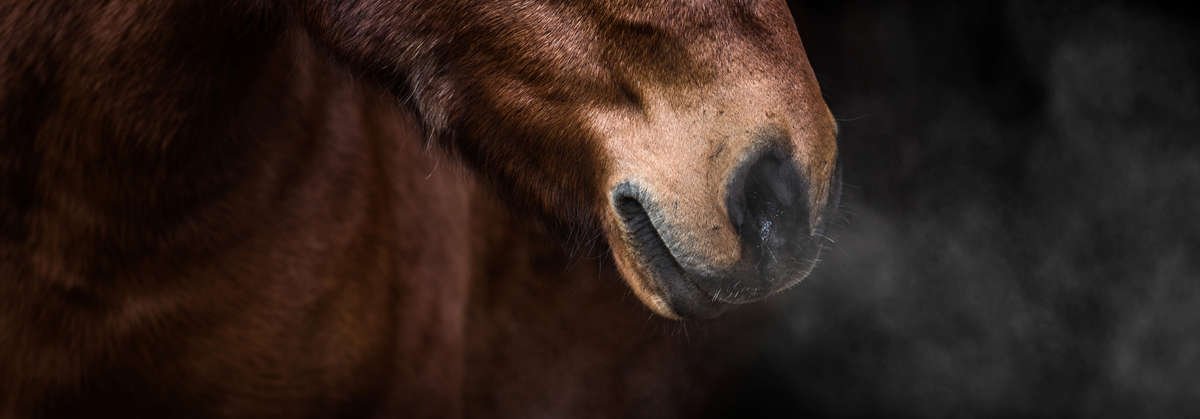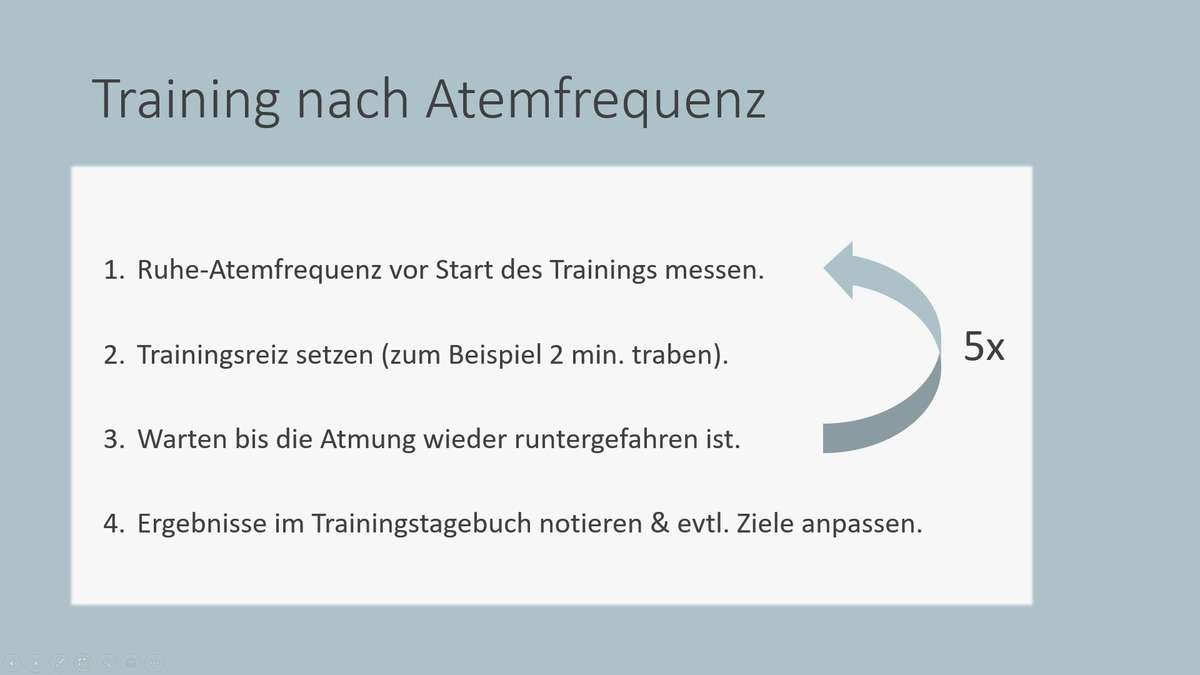Training horses with respiratory diseases is a controversial topic. Some say exercise a lot: "The lungs need to be well supplied with blood and the mucus needs to be removed." Others say: "Don't do too much, otherwise the horse will be overworked."
Horses with narrowed bronchi cannot breathe through their mouths like humans do when they are having difficulty breathing. If the bronchi are irritated by excessive strain, this can sometimes make the condition worse.
The right approach lies in the happy medium, but this is difficult to find. We interviewed Laura Mau from Soletherapiehof Mau about this. She recommends training based on breathing frequency, especially for horses with respiratory diseases. This ensures that the horse is not over- or under-challenged. If you are technically well-equipped, you can also use a heart rate monitor, but this is not absolutely necessary.
Horses with narrowed bronchi cannot breathe through their mouths like humans do when they are having difficulty breathing. If the bronchi are irritated by excessive strain, this can sometimes make the condition worse.
The right approach lies in the happy medium, but this is difficult to find. We interviewed Laura Mau from Soletherapiehof Mau about this. She recommends training based on breathing frequency, especially for horses with respiratory diseases. This ensures that the horse is not over- or under-challenged. If you are technically well-equipped, you can also use a heart rate monitor, but this is not absolutely necessary.
How do I measure respiratory rate?
To measure your breathing rate, all you need is a stopwatch.
At the beginning you have to decide whether to breathe in or out. Then you count each rise or fall of the stomach for 30 seconds and multiply the result by two. This gives you your horse's breathing rate per minute.
At the beginning you have to decide whether to breathe in or out. Then you count each rise or fall of the stomach for 30 seconds and multiply the result by two. This gives you your horse's breathing rate per minute.

What is the resting respiratory rate?
Before you start training, you should determine your horse's resting breathing rate. To do this, count the inhalations and exhalations as described above after your horse has stood for at least 30 minutes.
How do I structure the training?
Laura Mau works with certain limits in training, which should not be exceeded when the horse is working:
Light work – 30 breaths/min.
Medium work – 50 breaths/min.
Heavy work – 60 breaths/min.
During the first training session, it is important to determine what training condition your horse is in. After you have determined the resting respiratory rate, you can let your horse walk for 2 minutes and then measure the respiratory rate (RR) again. If this value is below the recommended 30 breaths/min., you can try out how your horse behaves in the trot in the next training step. However, if your horse is already above the recommended limit after 2 minutes of walking, you can conclude that this work was very strenuous and adjust the training accordingly.
For example, you can walk for 1 minute, then stop and wait until the AF has reached the resting AF again. If this is not a problem for your horse when walking, you can also trot and then let it walk until your horse has reached the AF for "light work" again. Ideally, the above values should not be exceeded for a healthy horse. Laura Mau recommends repeating the exercises about 5 times.
To keep an overview in the long term, we recommend that you keep a training diary. You can write down your goals in it, for example trotting for 2 minutes without exceeding an AF of 30 breaths/min. But you can also keep an eye on the values you actually achieved and see where your horse is at the moment. Ideally, you should also make a note of when you change something in the external circumstances, such as posture, or when you take new therapeutic measures. This makes it easier to identify both setbacks and progress in training.
For example, you can walk for 1 minute, then stop and wait until the AF has reached the resting AF again. If this is not a problem for your horse when walking, you can also trot and then let it walk until your horse has reached the AF for "light work" again. Ideally, the above values should not be exceeded for a healthy horse. Laura Mau recommends repeating the exercises about 5 times.
To keep an overview in the long term, we recommend that you keep a training diary. You can write down your goals in it, for example trotting for 2 minutes without exceeding an AF of 30 breaths/min. But you can also keep an eye on the values you actually achieved and see where your horse is at the moment. Ideally, you should also make a note of when you change something in the external circumstances, such as posture, or when you take new therapeutic measures. This makes it easier to identify both setbacks and progress in training.

What do I do if my horse's resting breathing rate is already at 30?
If your horse has a resting respiratory rate of over 30, you should train it so that it does not exceed the respiratory rate by 5 more breaths. Then you have to take a break until the resting respiratory rate is reached. In general, horses with a resting respiratory rate of over 30 require very precise training so as not to overload the bronchi.
The aim is for the horse to return to its resting AF more quickly over time. The faster the AF returns to normal, the fitter the horse is.
Should I warm up my horse before this training?
You can warm up your horse depending on your training goals.
If your horse is suffering from an acute infection and your goal is to only walk for 1 minute without the breathing rate increasing too much, then you do not need to warm up your horse. However, if you want to practice galloping for 2 minutes at a time, you should definitely warm up your horse beforehand.
warm up.
If your horse is suffering from an acute infection and your goal is to only walk for 1 minute without the breathing rate increasing too much, then you do not need to warm up your horse. However, if you want to practice galloping for 2 minutes at a time, you should definitely warm up your horse beforehand.
warm up.
My horse does not exceed the limits, how should I train it?
If your horse is suffering from a respiratory disease but does not exceed the limits in any gait, it does not currently appear to be having any difficulty breathing. For prevention, especially in the case of chronic diseases such as RAO, we recommend gallop training. When galloping, the horse takes one breath per stride, which places a very even load on the lungs and ensures good blood flow - ideal lung training that also strengthens the immune system.
When is the best time to inhale?
In the case of respiratory diseases, we always recommend supporting inhalation. Inhalation before exercise is particularly recommended if your horse has a lot of mucus. The exercise improves blood flow to the lungs and the mucus can be loosened and coughed up.
Do you have any other training tips for horses with respiratory diseases or questions for us? Then please contact us or comment below this post. ⬇️
For this article and the training of horses with respiratory diseases based on the respiratory rate, we interviewed Laura Mau of Soltherapiehof Mau. Laura and her sister Nora run a small therapy farm in Süderholz (Mecklenburg-Western Pomerania, Germany). They have specialised in the holistic
approach for horses with respiratory diseases and now even sell their own allergy hay.
approach for horses with respiratory diseases and now even sell their own allergy hay.


2 comments
Danke für diese nützlichen Tipps! Ich habe zwei Isländer, die generell ja eine höhere Atemfrequenz haben und bei denen auch Hechelatmung normal sein kann. Ist es da sinnvoll, die Richtwerte für das Training etwas höher anzusetzen?
Hallo, zunächst möchte ich mich für den informativen und hilfreichen Artikel bedanken. Eine Frage stellt sich mir allerdings doch. Der Grenzwert für Schritt und Trab ist 30 Atemzüge pro Minute. Wie ist es nach dem Galopp? Gilt der Galopp noch als leichte Arbeit? Also Grenze nach dem Galopp ebenfalls 30 Atemzüge pro Minute, oder dürfen die Atemzüge nach dem Galopp an die 50 Atemzüge heranreichen?
Vorab schon mal vielen Dank, liebe Grüße,
Elke Trost